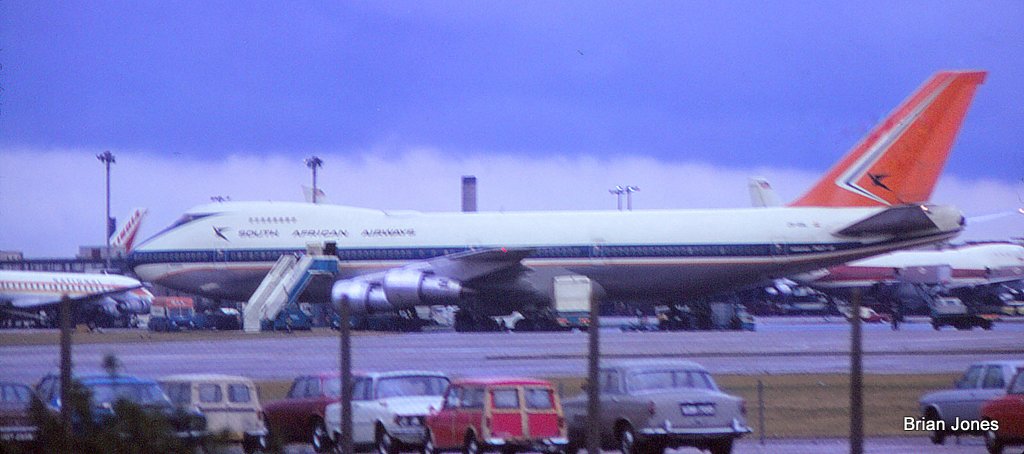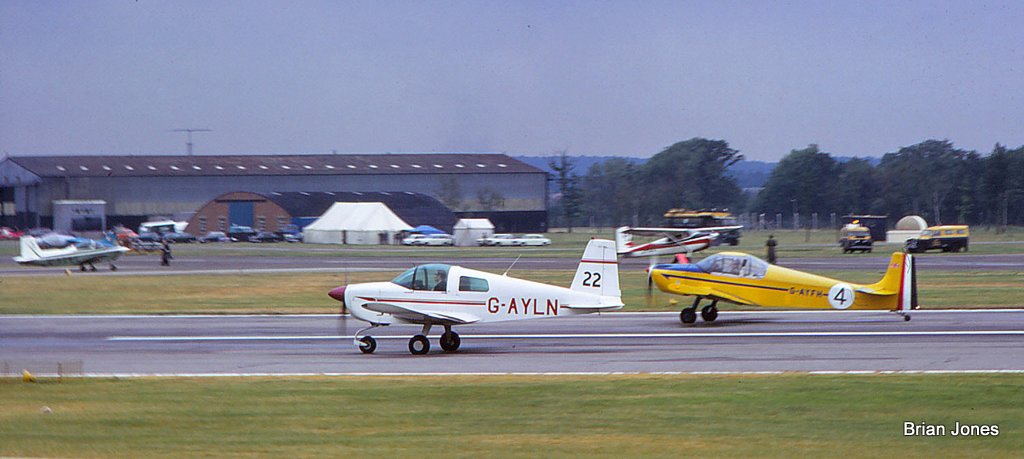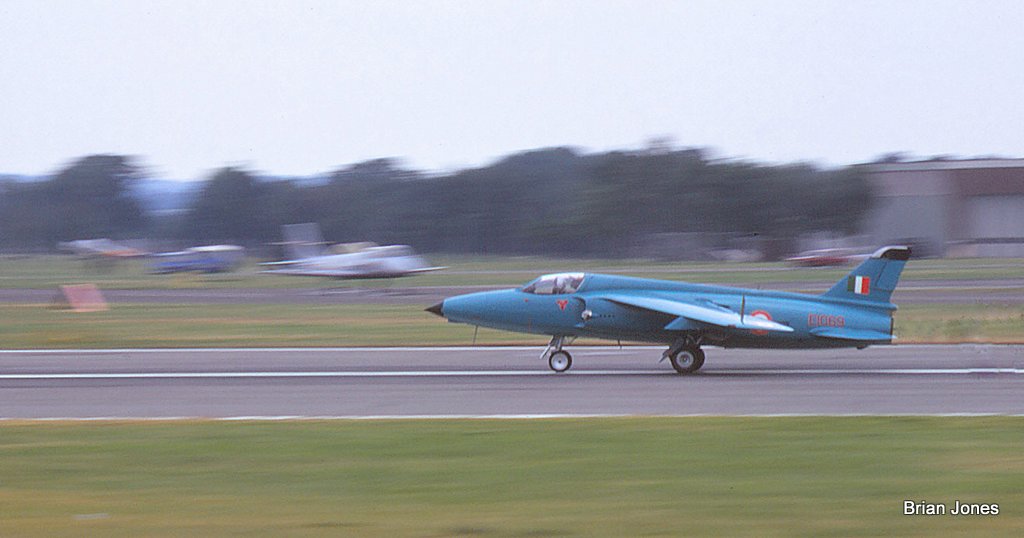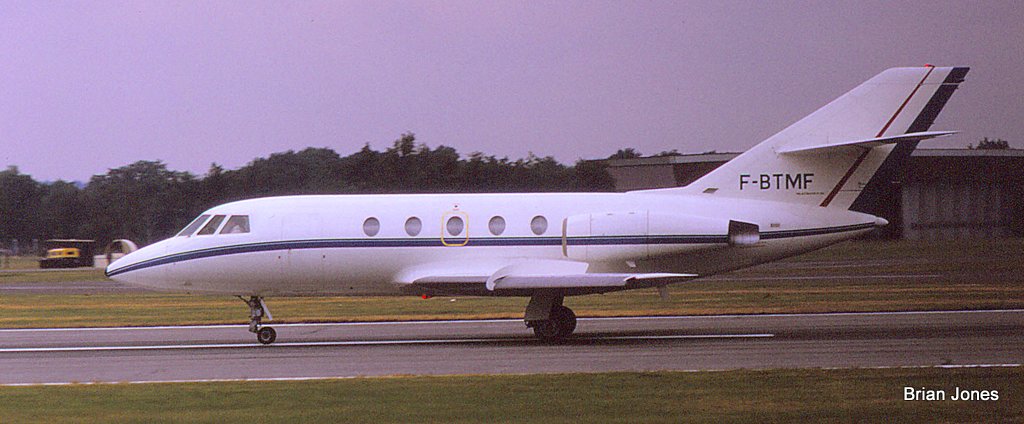MAS Heathrow early am visit, Saturday 9th September 1972Did wonder why I just had the one transparency in my collection from the Heathrow visit en route to SBAC Farnborough. Once digitalised, the answer is clear - it was so early in the morning and the light so dismal that Kodachrome 64 simply could not give sufficient shutter speed to overcome camera shake with a big, heavy 400mm lens attached to a semi-manual Prackita Nova 1B body. ZS-SAL a Boeing 747-244B of South African Airlines, a scheme that has changed little in 40+ years, mind-you neither has the Air India scheme (tail in background). The other Jumbo is TWA, while the Douglas DC-8-54 is N109RD of National.
 MAS Trip to SBAC Farnborough, Saturday 9th September 1972
MAS Trip to SBAC Farnborough, Saturday 9th September 1972The early to mid '70s were good years to visit Farnborough as the show had recently been enlarged to cover not just British built aircraft, but those with substantial British components (usually the engine), so there were delights such as the Indian indigenous designs along with a Saab Viggen, Mystere XX, Twin Otter and the Nomad amongst others. It was early enough to still have mass participation by the British Armed Forces and a major 'set piece' battle at the end 5 x Phantom FGR.2, 4 x Harrier GR.1A, 6 x Puma HC.1, 3 x Scout AH.1 a pair each of Hercules C.1, Andover C.1 and single Wessex HC.2 and Sioux AH.1 - quite a spectacle, even though we were all on the big march back to the remote bus park by that time.

A small static park of around a dozen aircraft included NZ6365/G-AZYN a BAC.167 Strikemaster 88 destined for the Royal New Zealand Air Force, surrounded by a complete catalogue of weaponry.

One of the British success stories of the time was the sale of 50 Harriers to the U.S. Marine Corps, with 158709 in the static, and another in the flying display. Interesting to note the sign refers to the aircraft as a Hawker Siddeley Harrier Mk.50, rather than the universal American name AV-8A.

Another success story for the British aviation industry, with an expanding order-book was the Britten-Norman BN-2A Islander. This aircraft N20JA is destined for delivery to US distributers, Jonas Aircraft.

40 years on cannot remember which bit of I-AEAM an Aermacchi AM.3c was British built, not that it matters much now, but was likely the engine.

.... but I do recall that the British bit of I-KMAK/mm54391 an Aermacchi MB.326K was definitely the engine.

Not the steadiest of shots, but L.1011 Tristar N305EA being towed from morning display near the crowd-line to the far side flight-line. Not the first Tristar at a Farnborough display, but this one celebrates B.E.A.'s order for the type in a mix of Eastern Airways (to whom the aircraft was destined) and BEA's tail and logo of the time.


In 1972 Farnborough was the starting point for a handicap air race. 19 aircraft are listed in my log for the day, from a Hornet Moth to a Cherokee Arrow. Note the official starter standing infront of an aircraft shortly to depart, hardly the safest of jobs!



There were three Swedish manufactured aircraft in the air display, an MFI.17F SE-XCF, the Saab 105Oe SE-DCX (later to become 1135 with the Austrian Air Force) and mighty Saab JA-37 Viggen 37002 of the Swedish Air Force. As if battling with slow film and poor light was not bad enough, having worked your way to the front of the crowd line at the right spot for a great landing action shot, when the right aeroplane comes along, a press photographer flashes his pass and can stand half way towards the runway right in way of the patient paying spectators and amateur photographers. One of the reasons why, when in the late 70s as the admission prices went up, I stopped going - indeed have not been ever since!


Like the IAT in the '80s, Farnborough in the 70's could produce aircraft the average enthusiast would never, ever see otherwise. Two such aircraft were an Indian built Folland Gnat F.1 and the HAL HJT.16 Mk.2 Kiran, both of the Indian Air Force. There were two Gnat F.1s to be seen E1069 and flight line spare E1070, along with Kiran U703 - just a shame my only photo of this type suffers from focus issues.






Competition in the around 9 to 18 seater class of aeroplane was fierce at that time. D-IMOL a Dornier Do.28D Skyservant in West German Navy colours; CF-DHA DHC-6 Twin Otter 300 exhibited by DHC; VH-SUR a GAF N-2 Nomad (a type which never attracted many sales in Europe); G-AZZM The BN-2A Mk.III Trislander exhibited by Britten-Norman Ltd; G-AXFV a HP.137 Jetstream 200 exhibited in rather bland colours by Jetstream Aircraft and finally G-AXPT a SC-7 Skyvan 3M shown by Shorts in camouflage in an effort to win further military orders.


The Lockheed Tristar N305EA might have been the largest aircraft present, and boasting purchase of the type by BEA - but this was overshadowed by an appearance of the flagship of the British aircraft industry, operating out of its Fairford base, the supersonic Concorde. G-BSST was one of only three prototype Concordes to have flown at the time. This example is now in the museum at Yeovilton.




Other products of the British aircraft industry shown at SBAC Farnborough 1972 included G-AZUK BAC.111-475, a variant produced to try attract new customers as sales faltered; Strikemaster 88 G-AZYK/NZ6364 was fresh off the Warton production line and shortly after delivered to New Zealand, incidentally the two Lightning F.1As in the distance are in the colours of the Wattisham TFF. Even as late as 1972, the Hawker Hunter was being factory refurbished and still sold in small numbers, G-BABM a Hunter F.74B was shown by Hawker Siddeley being formerly XF432 and G-9-373 and destined for service with the Singapore ADC. In contrast a type just entering full scale production was the BAC Jaguar, this being a prototype two-seater, XW566.



Westlands always put up a good showing at Farnborough shows. They were riding high on the success of a number of joint ventures, with Sea King, Gazelle, Puma and Lynx in production. XW231 a Puma HC.1 was exhibited by Westlands, as were a number of Lynx including XX153 in what today seems a strange combination of camouflage colours, while Sea King 43 062 was shortly to be delivered to 330 Skv of the Norwegian Air Force.


At the time known as the Mystere XX F-BTMF was C/no.184 of this successful French competitor for the HS.125 - which oddly as a type does not appear on my log, so may have departed the show on the Friday, although HS.748 G-AZJH was still present. A competitor of the BAC.1-11 series was the Dutch Fokker F.28-2000, represented by an attractively schemed demonstrator, PH-ZAX.
Interesting to reflect, that 40 years on, while some types illustrated have all but disappeared from the skies eg Concorde, BAC.1-11, Strikemaster, Hunter, Jaguar, Viggen, Harrier and Tristar; there are three types still in production, the BN-2 Islander, the DHC-6 Twin Otter, and the C-130 Hercules, while the Mystere XX has spawned a whole family of Falcon biz-jet designs.
The originals are Brian Jones' Kodachrome 64 transparencies in cardboard mounts, scanned on a CanoScan 9000F then cleaned, cropped, straightened, sharpened, re-contrasted and lightened (whichever were necessary) using Picasa, before uploading on Photobucket and downloading onto nwan forum by Brian Jones.